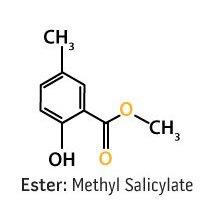Origin: a Latin derivative
meaning "Gift of the Earth."
Part 5: Oxygenated Compounds—Esters

Esters are formed when an esterification reaction occurs between an alcohol and a carboxylic acid functional group. An ester is essentially a combination of these two functional groups and incudes a carbon atom with a double bond to an oxygen molecule, a single bond to an oxygen molecule, and a single bond to another carbon molecule (usually written -COO- or -COOC-). Esters can be identified from the proper chemical name, which usually ends with the suffix “-yl, ” “-ate, ” or “-ester.” Common esters found in essential oils are methyl salicylate, linalyl acetate, and neryl acetate.
Main Health Effects:
- Calming, relaxing, soothing, and balancing effects on mood1
- Reduces the appearance of skin blemishes2
- Provides a soothing and warming sensation when applied topically3
| Essential Oil | Main Ester Constituent(s) | Amount |
| Birch3 | methyl salicylate | Approximately 99% |
| Wintergreen 1,2,3 | methyl salicylate | Approximately 99% |
| Roman Chamomile 1,2 | isobutyl acetate, isoamyl angelate, | Approximately 75% |
| Clary Sage 1 | linalyl acetate | Approximately 65% |
| Lavender 1,2 | linalyl acetate | Approximately 50% |
| Helichrysum 1,2 | neryl acetate | Approximately 40% |
| Bergamot 1,2 | linalyl formate | Approximately 40% |
| Jasmine 1,2 | benzyl acetate, benzyl benzoate | Approximately 40% |





